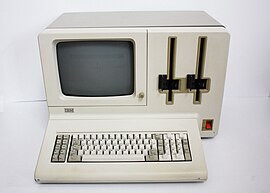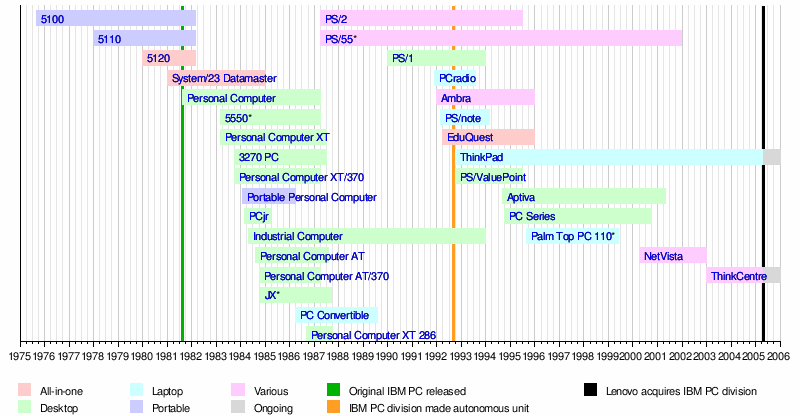Loading AI tools
From Wikipedia, the free encyclopedia
The System/23 Datamaster (Model 5322 desktop model[2] and Model 5324 floor model[3]) is an 8-bit microcomputer developed by IBM. Released in July 1981,[4] the Datamaster was the least expensive IBM computer until the far less expensive and far more popular IBM PC was announced in the following month.[5][6]
 | |
| Manufacturer | IBM |
|---|---|
| Type | All-in-one (5322), Computer tower (5324) |
| Release date | July 1981 |
| Introductory price | US$9,000 (equivalent to $30,163 in 2023) |
| Discontinued | 1985 |
| Operating system | System/34 BASIC |
| CPU | Intel 8085 @ 6.14 MHz ( effective 3.07 MHz) |
| Memory | 32 KB,64 KB,96 KB,128 KB DRAM 128 KB ROM[1] |
| Removable storage | 0-2 internal 8-inch floppy disk drives, optional external floppy drives |
| Display | Green phosphor CRT display (80 × 24 text) |
| Graphics | Intel 8275 |
| Sound | Internal beeper |
| Input | Model F keyboard |
| Connectivity | Printer port, disk drive port (optional), twinax (optional) |
| Mass | 95 lb (43 kg) |
| Predecessor | IBM 5120 |
| Successor | IBM Personal Computer |
| Related | IBM Displaywriter System |

The Datamaster is an all-in-one computer with text-mode CRT display, keyboard, processor, memory, and two 8-inch floppy disk drives in one cabinet.[2] The processor is an 8-bit Intel 8085[7] running at 6.14 MHz,[1] with bank switching to manage 128 KB of memory.[8] Available RAM was 32 KB (expandable to 128 KB[9]), and the machine had four internal expansion slots.[7] It could display 80 × 24 characters of text (each character with 10 × 14 pixels) with 256 possible characters, similar to the IBM PC's Code page 437, on a built-in 12" green phosphor CRT.[7][10]
The intention of the Datamaster was to provide a computer that could be installed and operated without specialists. A BASIC interpreter was built-in to the system. IBM decided to merge the Datamaster's BASIC implementation with System/34 BASIC, which reportedly delayed the Datamaster by almost a year.[8] When introduced, a single-screen Datamaster sold for around US$9,000 (equivalent to $30,163 in 2023). A second keyboard and screen could be attached in an extended configuration.
The familiarity the design group gained on the Datamaster project encouraged selection of an Intel CPU for the IBM PC. The delay caused by the decision to reuse System/34 BASIC in the Datamaster was one of the factors in IBM's selection of Microsoft BASIC for the PC (the other being the popularity of Microsoft BASIC on home computers at the time).[8]
A number of hardware components from the Datamaster were reused in the later IBM PC.[8] The PC's expansion bus, later known as the ISA bus, was based on the Datamaster's I/O bus.[11] The Datamaster's Model F keyboard with its 5251-style key arrangement was also reused in the PC, albeit with a serial interface (instead of the parallel one used on the Datamaster) and a new external housing.[8]
| Timeline of the IBM Personal Computer |
|---|
 |
| Asterisk (*) denotes a model released in Japan only |
Seamless Wikipedia browsing. On steroids.
Every time you click a link to Wikipedia, Wiktionary or Wikiquote in your browser's search results, it will show the modern Wikiwand interface.
Wikiwand extension is a five stars, simple, with minimum permission required to keep your browsing private, safe and transparent.